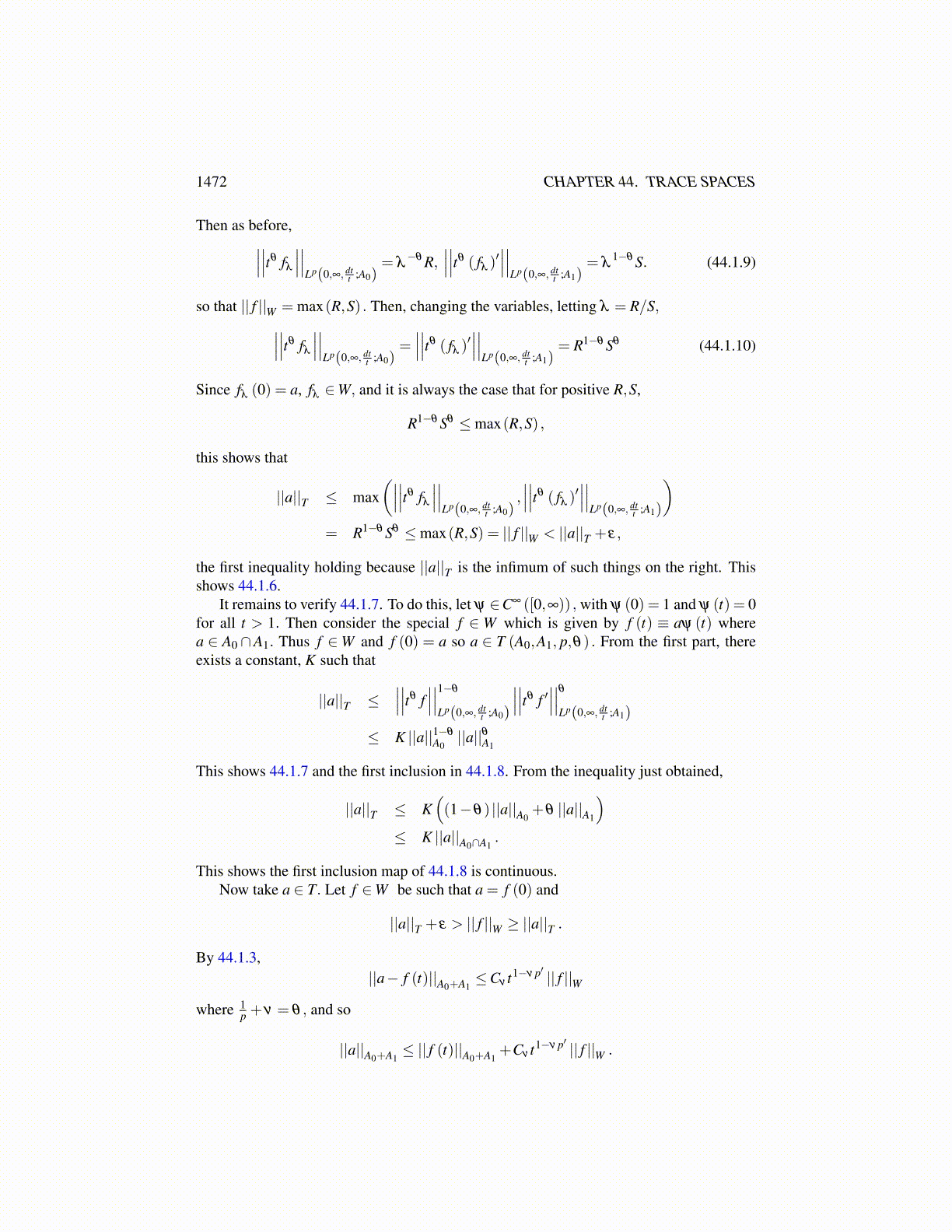
1472 CHAPTER 44. TRACE SPACES
Proof: That W/Z is a vector space is left to the reader. Why is ||·|| a norm? Supposeα ̸= 0. Then
||α [x]|| = ||[αx]|| ≡ inf{||αx+ z|| : z ∈ Z}= inf{||αx+αz|| : z ∈ Z}= |α| inf{||x+ z|| : z ∈ Z}= |α| ||[x]|| .
Now let ||[x]|| ≥ ||x+ z1||− ε and let ||[y]|| ≥ ||y+ z2||− ε where zi ∈ Z. Then
||[x]+ [y]|| ≡ ||[x+ y]|| ≤ ||x+ y+ z1 + z2||≤ ||x+ z1||+ ||y+ z2|| ≤ ||[x]||+ ||[y]||+2ε.
Since ε is arbitrary, this shows the triangle inequality. Clearly, ||[x]|| ≥ 0. It remains toshow that the only way ||[x]|| = 0 is for x ∈ Z. Suppose then that ||[x]|| = 0. This meansthere exist zn ∈ Z such that ||x+ zn|| → 0. Therefore, −x is a limit of a sequence of pointsof Z and since Z is closed, this requires −x ∈ Z. Hence x ∈ Z also because Z is a subspace.This shows ||·|| is a norm on W/Z. It remains to verify that W/Z is a Banach space.
Suppose {[xn]} is a Cauchy sequence in W/Z and suppose ||[xn]− [xn+1]|| < 12n+1 . Let
x′1 = x1. If x′n has been chosen let x′n+1 = xn+1 + zn+1 where zn+1 ∈ Z be such that
∣∣∣∣x′n+1− x′n∣∣∣∣ ≤ ||[xn+1− xn]||+
12(n+1)
= ||[xn+1]− [xn]||+1
2(n+1) <12n .
It follows {x′n} is a Cauchy sequence in W and so it must converge to some x ∈W. Now
||[x]− [xn]||= ||[x− xn]||=∣∣∣∣[x− x′n
]∣∣∣∣≤ ∣∣∣∣x− x′n∣∣∣∣
which converges to 0. Now if {[xn]} is just a Cauchy sequence, there exists a subsequencesatisfying
∣∣∣∣[xnk
]−[xnk+1
]∣∣∣∣ < 12k+1 and so from the first part, the subsequence converges
to some [x] ∈W/Z and so the original Cauchy sequence also converges. therefore, W/Z isa Banach space as claimed.
Definition 44.1.7 Define T (A0,A1, p,θ) = T, to consist of{a ∈ A0 +A1 : a = lim
t→0+f (t) for some f ∈W (A0,A1, p,θ)
},
the limit taking place in A0 +A1. Let γ f be defined for f ∈W by γ f ≡ limt→0+ f (t) . ThusT = γ (W ) . As above Z ≡ { f ∈W : γ f = 0}= ker(γ) .
Lemma 44.1.8 T is a Banach space with norm given by
||a||T ≡ inf{|| f ||W : f (0) = a} . (44.1.5)